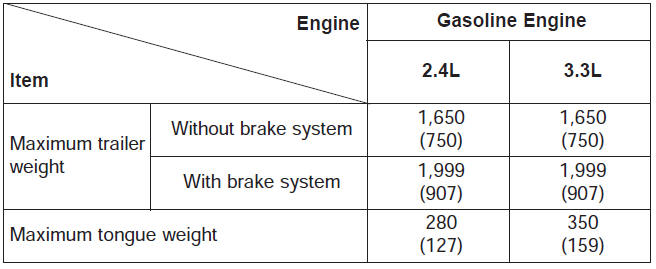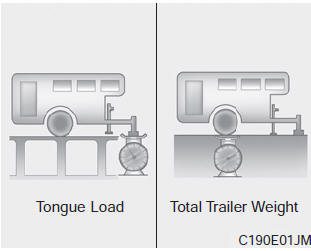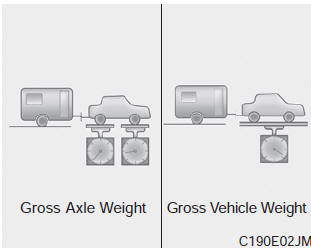 Kia Sorento: Driving with a trailer
Kia Sorento: Driving with a trailer
Towing a trailer requires a certain amount of experience. Before setting out for the open road, you must get to know your trailer. Acquaint yourself with the feel of handling and braking with the added weight of the trailer. And always keep in mind that the vehicle you are driving is now a good deal longer and not nearly so responsive as your vehicle is by itself.
Before you start, check the trailer hitch and platform, safety chains, electrical connector(s), lights, tires and mirror adjustment. If the trailer has electric brakes, start your vehicle and trailer moving and then apply the trailer brake controller by hand to be sure the brakes are working. This lets you check your electrical connection at the same time.
During your trip, check occasionally to be sure that the load is secure, and that the lights and any trailer brakes are still working.
Following distance
Stay at least twice as far behind the vehicle ahead as you would when driving your vehicle without a trailer. This can help you avoid situations that require heavy braking and sudden turns.
Passing
YouŌĆÖll need more passing distance up ahead when youŌĆÖre towing a trailer.
And, because of the increased vehicle length, youŌĆÖll need to go much farther beyond the passed vehicle before you can return to your lane. Due to the added load to the engine when going uphill the vehicle may also take longer to pass than it would on flat ground.
Backing up
Hold the bottom of the steering wheel with one hand. Then, to move the trailer to the left, just move your hand to the left. To move the trailer to the right, move your hand to the right. Always back up slowly and, if possible, have someone guide you.
Making turnsčö
When youŌĆÖre turning with a trailer, make wider turns than normal. Do this so your trailer wonŌĆÖt strike soft shoulders, curbs, road signs, trees, or other objects near the edge of the road. Avoid jerky or sudden maneuvers. Signal well in advance before turning or lane changes.
Turn signals when towing a trailer
When you tow a trailer, your vehicle has to have a different turn signal flasher and extra wiring. The green arrows on your instrument panel will flash whenever you signal a turn or lane change. Properly connected, the trailer lights will also flash to alert other drivers youŌĆÖre about to turn, change lanes, or stop.
When towing a trailer, the green arrows on your instrument panel will flash for turns even if the bulbs on the trailer are burned out. Thus, you may think drivers behind you are seeing your signals when, in fact, they are not. ItŌĆÖs important to check occasionally to be sure the trailer bulbs are still working. You must also check the lights every time you disconnect and then reconnect the wires.
Do not connect a trailer lighting system directly to your vehicleŌĆÖs lighting system. Use only an approved trailer wiring harness.
An authorized Kia dealer can assist you in installing the wiring harness.
WARNING
Failure to use an approved trailer wiring harness could result in damage to the vehicle electrical system and/or personal injury.
Driving on grades
Reduce speed and shift to a lower gear before you start down a long or steep downgrade. If you donŌĆÖt shift down, you might have to use your brakes so much that they would get hot and no longer operate efficiently.
On a long uphill grade, shift down and reduce your speed to around 45 mph (70 km/h) to reduce the possibility of engine and transaxle overheating.
If your trailer weighs more than the maximum trailer weight without trailer brakes and you have an automatic transaxle, you should drive in D (Drive) when towing a trailer.
Operating your vehicle in D (Drive) when towing a trailer will minimize heat build up and extend the life of your transaxle.
CAUTION
- When towing a trailer on steep grades (in excess of 6%) pay close attention to the engine coolant temperature gauge to ensure the engine does not overheat. If the needle of the coolant temperature gauge moves across the dial towards ŌĆ£HŌĆØ (HOT), pull over and stop as soon as it is safe to do so, and allow the engine to idle until it cools down. You may proceed once the engine has cooled sufficiently.
- You must decide driving speed depending on trailer weight and uphill grade to reduce the possibility of engine and transaxle overheating.
Parking on hills
Generally, if you have a trailer attached to your vehicle, you should not park your vehicle on a hill. People can be seriously or fatally injured, and both your vehicle and the trailer can be damaged if they unexpectedly roll downhill.
However, if you ever have to park your trailer on a hill, here's how to do it:
WARNING - Parking on a hill
Parking your vehicle on a hill with a trailer attached could cause serious injury or death, should the trailer break loose or brake stops working.
1.Pull the vehicle into the parking space. Turn the steering wheel in the direction of the curb (right if headed downhill, left if headed up hill).
2.If the vehicle has a manual transaxle, place the vehicle in neutral. If the vehicle has an automatic transaxle, place the vehicle in P (Park).
3.Set the parking brake and shut off the engine.
4.Place chocks under the trailer wheels on the down hill side of the wheels.
5.Start the vehicle, hold the brakes, shift to neutral, release the parking brake and slowly release the brakes until the trailer chocks absorb the load.
6.Reapply the brakes, reapply the parking brake and shift the vehicle to R (Reverse) for manual transaxle or P (Park) for automatic transaxle.
7.Shut off the vehicle and release the vehicle brakes but leave the parking brake set.
WARNING - Parking brake
It can be dangerous to get out of your vehicle if the parking brake is not firmly set. If you have left the engine running, the vehicle can move suddenly. You or others could be seriously or fatally injured.
When you are ready to leave after parking on a hill
1. With the manual transaxle in Neutral or automatic transaxle in P (Park), apply your brakes and hold the brake pedal down while you:
- Start your engine;
- Shift into gear; and ŌĆó Release the parking brake.
2. Slowly remove your foot from the brake pedal.
3. Drive slowly until the trailer is clear of the chocks.
4. Stop and have someone pick up and store the chocks.
Maintenance when trailer towing
Your vehicle will need service more often when you regularly pull a trailer.
Important items to pay particular attention to include engine oil, automatic transaxle fluid, axle lubricant and cooling system fluid. Brake condition is another important item to frequently check. Each item is covered in this manual, and the Index will help you find them quickly. If youŌĆÖre trailering, itŌĆÖs a good idea to review these sections before you start your trip.
DonŌĆÖt forget to also maintain your trailer and hitch. Follow the maintenance schedule that accompanied your trailer and check it periodically.
Preferably, conduct the check at the start of each dayŌĆÖs driving. Most importantly, all hitch nuts and bolts should be tight.
CAUTION
- Due to higher load during trailer usage, overheating might occur in hot days or during uphill driving. If the coolant gauge indicates overheating, switch off the A/C and stop the vehicle in a safe area to cool down the engine.
- When towing check transaxle fluid more frequently.
If you do decide to pull a trailer
Here are some important points if you decide to pull a trailer:
- Consider using a sway control.You can ask a hitch dealer about sway control.
- Do not do any towing with your vehicle during its first 1,200 miles (2,000 km) in order to allow the engine to properly break in. Failure to heed this caution may result in serious engine or transaxle damage.
- When towing a trailer, be sure to consult an authorized Kia dealer for further information on additional requirements such as a towing kit, etc.
- Always drive your vehicle at a moderate speed (less than 60 mph (100 km/h)).
- On a long uphill grade, do not exceed 45 mph (70 km/h) or the posted towing speed limit, whichever is lower.
- The chart contains important considerations that have to do with weight:

To identify what the vehicle trailering capacity is for your vehicle, you should read the information in ŌĆ£Weight of the TrailerŌĆØ that appears later in this section.
Weight of the trailer

What is the maximum safe weight of a trailer? It should never weigh more than the maximum trailer weight with trailer brakes. But even that can be too heavy.
It depends on how you plan to use your trailer. For example, speed, altitude, road grades, outside temperature and how often your vehicle is used to pull a trailer are all important.
The ideal trailer weight can also depend on any special equipment that you have on your vehicle.
Weight of the trailer tongue

The tongue load of any trailer is an important weight to measure because it affects the total gross vehicle weight (GVW) of your vehicle.
This weight includes the curb weight of the vehicle, any cargo you may carry in it, and the people who will be riding in the vehicle. And if you will tow a trailer, you must add the tongue load to the GVW because your vehicle will also be carrying that weight.
The trailer tongue should weigh a maximum of 10% of the total loaded trailer weight, within the limits of the maximum permissible trailer tongue load. After you've loaded your trailer, weigh the trailer and then the tongue, separately, to see if the weights are proper. If they arenŌĆÖt, you may be able to correct them simply by moving some items around in the trailer.
WARNING - Trailer
- Never load a trailer with more weight in the rear than in the front. The front should be loaded with approximately 60% of the total trailer load; the rear should be loaded with approximately 40% of the total trailer load.
- Never exceed the maximum weight limits of the trailer or trailer towing equipment. Improper loading can result in damage to your vehicle and/or personal injury. Check weights and loading at a commercial scale or highway patrol office equipped with scales.
- An improperly loaded trailer can cause loss of vehicle control.
 Trailer towing
Trailer towing
If you are considering towing with your vehicle, you should first check with
your country's Department of Motor Vehicles to determine their legal requirements.
Since laws vary the requirements f ...
 Vehicle load limit
Vehicle load limit
Tire and loading information label
The label located on the driver's door sill gives the original tire size, cold
tire pressures recommended for your vehicle, the number
of people tha ...
See also:
Rear Body
* These dimensions indicated in this figure are actual-measurement
dimensions. [ Unit : mm (inch) ]
Side outer p ...
Troubleshooting
Diagnosis And Testing - Power Tailgate System
The power Tailgate system is a complex system containing many components.
In order to perform conclusive testing, or receive outputs the power T ...
Tightening Torque
Items
N.m
Kgf.m
lb-ft
Front and rear doors
Door hinge to body
33.3~41.2
3.4~4.2
24.6~30.4
Door hinge to door
21 ...
